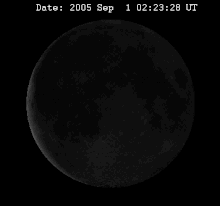Nuns

The " Nones " ( Latin Nonae ) designate the eighth day (a Nundinum ) before the Ides , the full moon . Similarly, the Tubilustrium was always a Nundinum after the Idus.
Origin and calculation
The term is probably derived from the distance between the first quarter of the moon and the full moon, which is eight or nine days: "Ninth day before the Ides".
Censorinus reports in his writings about the nuns in the Roman calendar . Friedrich Karl Ginzel suspects in this context that these days were originally counted up, since in the early days of the Roman calendar the months after the sighting of the new light were proclaimed, a technique that is still used today for Ramadan .
The later counting down could only take place with knowledge of the synodic length of the month and the lunar year . The nuns were also used as “days of proclamation of the monthly festivals”. Therefore, no monthly festival fell in the first quarter of the moon in the Roman calendar.
The division of the nuns was later carried out in a schematic manner, detached from the actual synodic lunar months. The months Martius , Maius , Quintilis and October comprised 31 days in the Roman calendar. The nuns were fixed on the seventh day and the full moon on the fifteenth day during these months. In the twenty-nine-day months, however, the nuns were on the fifth and the full moon on the thirteenth. The regulation of the twenty-nine-day months also applied to the leap months and February .
The basis of the calculation was always the new moon . This ensured that the period between the full moon day and the following new moon was sixteen days in each of the thirty-one and twenty-nine day months. The exception was February with fifteen days.
Nonsense days
What is striking is the finding that the nuns in the Roman Republic in the months of Januarius to December carry all other nouns except the "G" ("A, B, C, D, E, F and H"). The assumption that the coincidence of the letter "G" with a leap day was prevented is not borne out by current switching practice. In order to prevent the assignment with the "G", the switching should have taken place in February; this would have made “G” a “D” at the turn of the year. Another three-day switching should have been carried out next February to prevent the collapse again; using the leap month Mercedonius would have required seven days. However, this procedure was an impossible procedure in terms of calendar technology.
| Nones and distribution of the Nundinae days as well as the day character up to 46 BC Chr. | ||||
| month | Day | Nundinae | Day character | Festive events |
|---|---|---|---|---|
| Ianuarius | 5 | E. | F. | |
| February | 5 | B. | N | |
| Mensis intercalaris | 5 | C. | F. | |
| Martius | 7th | H | F. | |
| Aprilis | 5 | E. | N | |
| Maius | 7th | D. | N | |
| Junius | 5 | A. | N | |
| Quintilis | 7th | H | N | |
| Sextilis | 5 | E. | N | |
| September | 5 | B. | F. | |
| October | 7th | A. | F. | |
| November | 5 | F. | F. | |
| December | 5 | C. | F. | |
literature
- Friedrich Karl Ginzel : Handbook of mathematical and technical chronology, Vol. 2 - Calculation of the time of the Jews, the primitive peoples, the Romans and Greeks as well as supplements to the 1st volume - . Austrian Literature Online, Innsbruck 2007 (reprint of the original edition Leipzig 1906) ISBN 3-226-00428-X
- Jörg Rüpke : Calendar and Public: The History of Representation and Religious Qualification of Time in Rome . de Gruyter, Berlin 1995, ISBN 3-11-014514-6
Individual evidence
- ^ Jörg Rüpke: Calendar and Public: The History of Representation and Religious Qualification of Time in Rome . P. 585.
